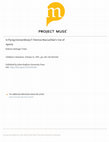Articles & Chapters by Roberta Trites
English Journal, 2019
This article argues for the value of preparing students to identify the presence of neoliberal id... more This article argues for the value of preparing students to identify the presence of neoliberal ideologies that amplify racial stratification by defining entire groups of people as “disposable” The authors examine a YA dystopian novel to demonstrate how the text can be interpreted as a critique of neoliberalism.
Papers by Roberta Trites
First Opinions, Second Reactions, 2010
English Journal
Two professors address the consequences of withholding knowledge from young people and offer a ra... more Two professors address the consequences of withholding knowledge from young people and offer a rationale for teaching challenged books and talking points for teachers and librarians.
Children's Literature Association Quarterly
Tulsa Studies in Women's Literature
Literary Conceptualizations of Growth
Literary Conceptualizations of Growth
Race in Young Adult Speculative Fiction
In this chapter, Sean P. Connors and Roberta Seelinger Trites argue that “neoliberalism has influ... more In this chapter, Sean P. Connors and Roberta Seelinger Trites argue that “neoliberalism has influenced the erasure of race” in contemporary YA dystopian fiction. They devise a framework for determining if a YA novel critiques or condones neoliberalism and, thus, “whether it is reproducing, complicating, or resisting” neoliberal ideologies. To demonstrate how YA dystopian novels reproduce neoliberalism as a means to privilege the individual and erase race and racist power structure, the essay considers Sherri L. Smith’s Orleans as a counterexample, arguing that Smith’s novel “employs neoliberalism” to challenge “the erasure of race.”

Little Women at 150, 2022
Roberta Seelinger Trites connects the use of The Pilgrim’s Progress in Little Women with the essa... more Roberta Seelinger Trites connects the use of The Pilgrim’s Progress in Little Women with the essays of Ralph Waldo Emerson. She argues that Alcott “uses The Pilgrim’s Progress to articulate a number of very Emersonian principles. In that sense, The Pilgrim’s Progress serves as an intertextual palimpsest painted over various Transcendental texts in Little Women. Alcott appears to have used The Pilgrim’s Progress to hide her Transcendental agenda.” Alcott, Trites argues, “relied on a text popular with the reading public, an alternative text to Emerson’s essays that superficially demonstrated many of the same values but that was more accessible to juvenile readers: John Bunyan’s The Pilgrim’s Progress.” By doing so, “Alcott creates a philosophical space in which her female characters can articulate ideas about language, nature, and self—and without fear of censure.”
For at least forty years, teachers have theorized about how to empower girls in the literature cl... more For at least forty years, teachers have theorized about how to empower girls in the literature classroom-and the solution for many has been to engage feminist pedagogies. In this chapter, we trace how issues of critical thinking have led feminism (and misunderstandings of feminism) to intersect with secondary English education in the United States in order to contextualize a study we conducted of four high school teachers who self-consciously problematize gender while attempting to expose issues of critical thinking in their literature classrooms. We follow our consideration of texts and teachers with a demonstration of how two Young Adult (Y A) novels marketed to girls-E. Lockhart's The Disreputable History if Frankie Landau-
Children's Literature Association Quarterly, 2018

Barnboken, Dec 19, 2014
Maria Nikolajeva's Reading for Learning: Cognitive Approaches to Children's Literature (2014) mak... more Maria Nikolajeva's Reading for Learning: Cognitive Approaches to Children's Literature (2014) makes a compelling argument for the usefulness of cognitive literary theory in the analysis of children's literature. Nikolajeva positions her work as an effort to bridge the disciplines of educational theory and literary study, asking this: "If literature is [...] a powerful implement for enlightening the reader, for conveying knowledge, for building citizenship, how exactly does this work; what is the mechanism of the epistemic value of literature specifically targeting an audience that purportedly has a different cognitive capacity than the sender?" (3). Nikolajeva believes that cognitive criticism helps answer these questions. She defines cognitive criticism as "a cross-disciplinary approach to reading, literacy, and literature that suggests rethinking the literary activity as such [...], including interaction between readers and works of literature, but also the ways literary texts are constructed to maximise, or perhaps rather optimise reader engagement" (4, italics in the original). Within this paradigm, cognitive literary criticism involves not only the interactions between readers and authors, but also "the relationship between representation and its referent in the perceptible world" (4). She acknowledges that "while reader-response theories deal with how readers interact or transact with fiction, cognitive criticism also encompasses the question of why this interaction/transaction is possible" (8). Key concepts throughout the book interrogate representation, perception, temporality, memory, and other aspects of cognition, including emotion, dreaming, and ethical decision-making. That cognition is an embodied phenomenon is also a foundational assumption in this work: "Our engagement with fiction is not transcendental; it is firmly anchored in the body, both within the body and the body's position in space and time" (10).
Studies in the Novel, 2015
The Lion and the Unicorn, 1994

International Research in Children's Literature, 2012
Cognitive narratology provides a way to explore discourse as the product of embodied beings as it... more Cognitive narratology provides a way to explore discourse as the product of embodied beings as it simultaneously affects those embodied beings. Cognitive narratology specifically investigates how embodiment influences both the author's discursive creation of story and its subsequent meaning-making as a function of the reader's cognition. This essay explores three aspects of cognitive narratology pertinent to adolescent literature: metaphor, scripts, and blending – all of which are biologically and culturally situated cognitive processes. The essay first examines embodied theories of character growth within the field of adolescent literature before moving to a close reading of Jay Asher's Thirteen Reasons Why to illustrate the relationships between embodied metaphors, scripts, and blending. Thirteen Reasons Why demonstrates how the process of blending allows authors to fuse embodied metaphors and scripts into new narratives about adolescent growth. At stake are interpreti...

Children's Literature, 1995
Three of Patricia MacLachlan's novels have female protagonists between the ages of ten and twelve... more Three of Patricia MacLachlan's novels have female protagonists between the ages of ten and twelve: Cassie Binegar, Unclaimed Treasures, and The Facts and Fictions of Minna Pratt.l Each of these novels is a narrative about a girl who feels silenced by external forces and who subsequently regains a more developed interior voice than the one she has lost. As a result, in these stories the traditional narrative of female silencing is itself silenced by revisionary narratives of female articulation. Many feminists have pointed to female voicelessness as a recurring obstacle for women in our culture. Psychological theorists posit cultural silencing as one of the dominant forces that shape female adolescence,2 and literary theorists have shown how this social phenomenon of silencing manifests itself in literature.3 Recently, feminists have formulated strategies that promote narrative as a way for women to connect so that they might overcome this socio-literary silencing.4 Those of MacLachlan's novels that focus on the development of préadolescent girls are remarkable in the ways that they combine these literary and psychological theories. After each of Mac-Lachlan's girl protagonists interacts with the narratives of other female characters, she resolves a conflict with her mother5 and gains understandings of both her own sexuality6 and of some artistic process. Her increased awareness leads to her ability to formulate a "new fiction" that breaks from traditional cultural silencing. And their victories serve as a literary tour deforce for feminism. Central to these victories is the value each of these texts places on language. Until MacLachlan's préadolescent girls learn the power that language gives them, they are frustrated into silence because they try to understand abstract concepts in concrete, physical terms.7 MacLachlan's texts illustrate this frustration by relying on the rhe-Children's Literature 23, ed. Francelia Butler, R.
Children's Literature Association Quarterly, 2014
Children's Literature Association Quarterly, 2008
Children's Literature Association Quarterly, 2013
Children's Literature Association Quarterly, 2011







Uploads
Articles & Chapters by Roberta Trites
Papers by Roberta Trites